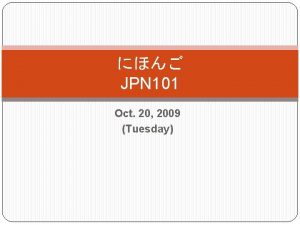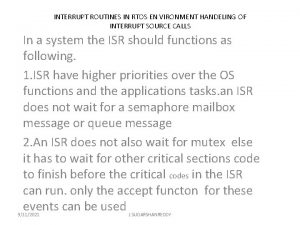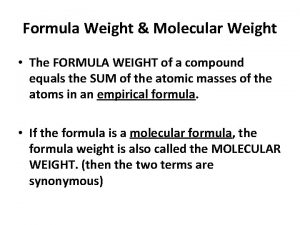Essential Elements of Weight Routines Essential Elements of









- Slides: 9

Essential Elements of Weight Routines

Essential Elements of Weight Routines 1. ) Make sure that the routine includes exercised for each of the following muscle groups: • • • Glutes Quadriceps Hamstrings Calves Biceps Chest Back Abdominals Shoulders Triceps

2. Do the Exercises in the Right Order Upper Body • Chest and Back • Shoulders • Arms Core • Abdominal and Lower Back ** DON’T exercise the Lower Body same muscle • Glutes group two • Thighs • Calves and Shins days in a row**

3. ) Perform the last repetition to fatigue • Use enough weight so that you are exerting serious effort by the last repetition.

How to Weight Train 1. ) Sets and Repetition • A “rep” is the number times a movement is done in sequence without a break. • A ‘set” is a number a times a sequence of reps is completed • When writing your program the number of sets is written first then the number of reps. 2. ) Rest Intervals • The amount of rest between sets and between Exercises. 3. ) Intensity • Adjust by the changing the resistance and the number of sets and reps

How to Weight Train 4. ) Proper Technique • • • Move the weight through the joint’s entire range of motion Avoid twisting or jerking motions to help move the weight. Move the weight smoothly Establish and maintain proper body alignment If it hurts STOP, listen to your body, slight twinges of discomfort should not be ignored.

Weight Training Principles 1. ) The FITT Principles. ( Frequency, Intensity, Type and Time) 2. )Gradual Progressive Overload • The overload principle states that the body must receive a stimulus greater than it is used to for it to gain any major benefits. • The key is to remember the gradual and progressive components of the GPO principle – lifting too much weight too fast will most certainly result in injury. • The principle of progression says to start gradually and add a little each workout. • This can be achieved by increasing the resistance, duration, frequency of activity and type of activity.

Weight Training Principles 3. ) Individuality and Specificity • The principle of individually simply recognizes that everyone is different and that exercise programs should be designed with these differences in mind. • Before you begin to design an exercise program you need to recognize your physical attributes and determine what your motivations are. • The principle specifically states that the body will respond and make improvements that are specific to the types of stimulus put on it. • When designing a program you need to be clear what your goals are in order to ensure you are specifically targeting and training certain muscle groups properly.

Weight Training Principles 4. ) Adaptation • Your body is an amazing machine that will adapt to whatever you do. This is why people gain weight and lose strength and flexibility when they do nothing. • When starting a weight training program you will notice changes in your body within the first 2 – 3 weeks. • It is also important to remember that since your body adapts so well, in order to continually promote growth and change, it is a good idea to change your program every 6 – 8 weeks.

















